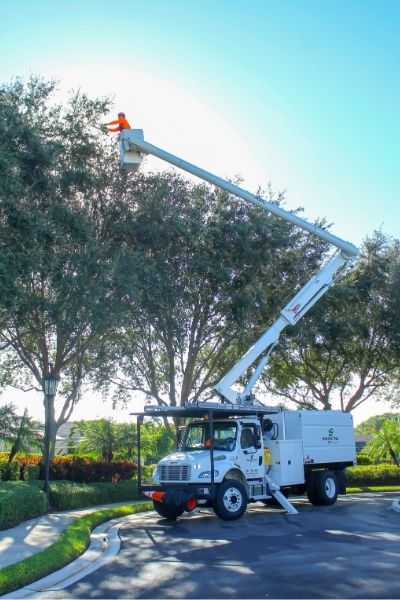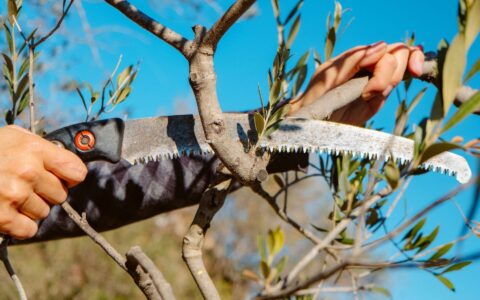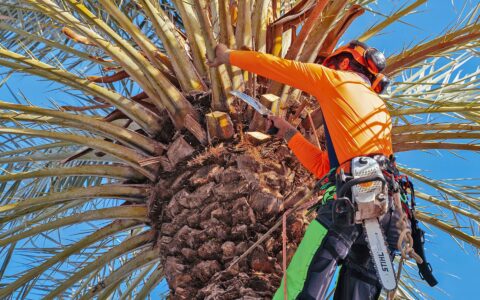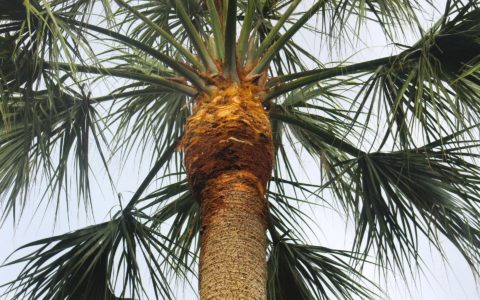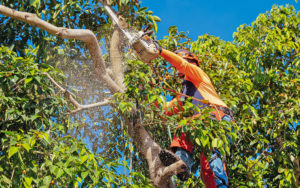We often get calls from people who want to reduce the size of their tree. Maybe the tree has outgrown the area in which it was planted, or it’s blocking their view, touching power lines, or hitting their roof when the wind blows. Although they like the tree, they want it to be shorter and/or smaller. So they ask us to “cut it back” to the desired size (commonly referred to as “hat-racking” or "topping"). Usually, they’ve seen their neighbor’s trees cut this way and assume it’s a normal tree care practice.
If that describes your situation, you’ll be interested to know why we often turn down those jobs. Instead, we try to educate our customers about the proper way to reduce the size and volume of a tree’s canopy: crown reduction pruning.
How NOT to Reduce a Tree’s Size
At one time or another, we’ve all been guilty of not reading small print, or not following directions. Often there are no repercussions from these oversights beyond starting a task again. But when it comes to bad tree pruning, there is no do-over. A bad pruning cut can be forever.
Topping or Hat-Racking
The most devastating pruning cut for a tree is the topping, hat-racking, or heading cut that’s often used to reduce the size of a tree’s canopy. It can also be called rounding-over, stubbing, tipping, lopping, or dehorning.
Hat-racking is a drastic “pruning” method that removes the tops of trees. It promises a lot of things but delivers quite the opposite. In fact, topping a tree is the second most common cause of tree decline and death (the first is planting a tree too deeply in the ground).
Despite all of the articles (including this one from the University of Florida) and notices out there about the disastrous effects of tree topping, you can still see it done widely. In the most extreme circumstances (which we’ve noticed still happens quite frequently), trees are cut down to nothing more than stubs.
This type of damaging pruning is not done by ISA certified arborists. Homeowners and HOAs should never hire a tree pruner who advertises, suggests, or performs topping or hat-racking on trees of any size.
Sadly, damaging and irreversible tree pruning happens every day. In many cases, homeowners and HOA representatives may not understand the seriousness of the damage that’s being inflicted on their trees. They may also get bad advice or may choose a low price quote from an untrained tree pruner over a higher bid from a certified arborist.
DO NOT TOP OR HAT-RACK TREES! In Broward County, topping is considered tree abuse and is a violation of Article Fourteen of the Broward County Code. Similarly, this type of over-pruning is a violation of Chapter 24 of the Miami-Dade County Code.
What to Know About Reducing Tree Size
Tree Pruning is a Science
To understand when, where, and how to prune a tree, an arborist must have a real understanding of the tree’s internal workings, its response to wounds (such as pruning cuts), and its growth patterns.
The Effects of Correct Versus Incorrect Pruning
Crown reduction often involves pruning all parts of a tree’s crown. An experienced arborist makes each cut with purpose and as part of the larger pruning plan.
In contrast, incorrect or unplanned tree pruning just reduces the overall size and appearance of a tree. It doesn't consider branch structure, growth habits, or the tree’s stress response to wounding cuts. The end result is a tree that doesn't look "right" and that responds by quickly putting out weak, spindly growth that's at high risk of breakage and will need to be pruned again in another year or two.
More is Not Always Better
The volume of branches and foliage removed from a tree is not a sign that you’ve gotten your money’s worth. It’s a sign that your tree pruner doesn’t understand the importance of limited, strategic pruning cuts that shape and guide the long-term growth of a tree.
>> Learn more about proper tree pruning methods and FAQs
About Crown Reduction
Crown reduction reduces the overall size of a tree by selectively pruning branches. This type of pruning creates a sound, balanced branch structure that’s shorter than the tree’s original height, and with a reduced horizontal spread. Proper crown reduction maintains the natural form of the tree.
Good crown reduction combined with regular, minimal pruning is the most cost-efficient way to ensure your trees’ health and vigor over their lifetime.
Crown reduction is achieved by pruning back a tree’s branch leaders or branch terminals (the endpoint of a branch). These cuts are made at an intersection with an existing lateral branch - not at a random point between branches! The lateral branches are carefully chosen; they must have a diameter large enough to become a new branch leader or terminal.
The science (and the art!) of crown reduction lies in selecting the right branch leaders to prune back, and the right lateral, or side, branches to become new leaders. What you want is a strong, natural-looking branch ramification, or transition from large- to small-diameter branches. This careful transition is one of the hallmarks of professional pruning. The arborist can “see” the results of his or her pruning cuts before making them, so each pruned branch is part of a careful plan to reduce and shape the tree’s crown with minimal cuts.
Don't Take it All Off!
Crown reduction pruning should not remove more than 20-25% of a tree’s branches and foliage. That maximum percentage should be even lower for very mature trees or trees that are stressed or in decline. This is important, as pruning stimulates new growth and that growth needs to be in proportion to a tree’s vigor and stored energy reserves. Too much pruning on a tree that’s weakened from disease or water stress is unlikely to result in a rejuvenated tree. Instead, it can tax the tree’s energy reserves entirely and result in stunted, epicormic shoots instead of new leafy branches.
Branch Thinning
Another part of crown reduction can be branch thinning. This involves pruning selected branches to their origin point on large, scaffold branches or the tree’s main trunk. Thinning can open up a dense tree crown to allow light and air in, and can re-balance the weight of branches to guide their future growth.
Thinning is not always needed and should be done carefully to avoid lion-tailing. This is another harmful practice in which side branches and foliage are removed along a branch except for its endmost points, creating an unbalanced and unhealthy crown.
The Value of Proper Crown Reduction
Pruning and crown reduction of your trees is intended to reduce their overall size without interrupting their natural growth patterns or creating new and future pruning problems. It can be a vital component in saving large, mature trees that may have outgrown their location and are encroaching onto neighboring property, power lines, or roadways.
Damaging a mature tree with topping or hat-racking, on the other hand, leaves pruning wounds open to disease and insect pests and creates new, poorly-attached branches that will have to be removed again. This is part of the cycle of poor pruning that exponentially increases the maintenance costs of trees, and often leads to tree decline and death.
You can't replace the value of a lost mature tree simply by planting a new, young tree. A mature tree provides shade, cooling, wildlife habitat, carbon sequestration, and contributes to the visual structure or composition of a property or neighborhood.
Be Certain You Hire the Right Tree Trimming Company
To ensure the life-long health of your trees, hire only ISA certified arborists who do not top trees. Take the time to understand the long-term difference in quality, safety, and subsequent growth that results from a careful, professional tree pruning. And do not make a decision based solely on cost when the low price is provided by an untrained tree pruner who is not an ISA certified arborist.
PRO TIP: Find a credentialed arborist fast, or verify an arborist’s credential on the ISA’s website before you hire a tree pruning company. In Broward County, all businesses or governmental agencies that perform tree trimming are required to obtain a Broward County Tree Trimmer License. Make sure they have one. Sherlock Tree Company has three ISA Certified Arborists on staff – Jonathan Wolfson (FL-6648A), Dennis Forgione (FL-5918A), and Mark Merritt. You can verify their qualifications here. Sherlock Tree also has a Class A Tree Trimmer License – No. A-1205.
Instead of risking the health and appearance of your trees with hat-racking or other improper pruning techniques, treat your trees with professional care. Our skilled and experienced arborists value trees and work to keep them healthy and vigorous while enhancing their natural form. Give us a call and we’ll help keep your trees healthy and sound throughout their life.
Call Sherlock for quality tree services
Whether you're looking for specific tree care services, such as palm trimming, tree removal, or disease treatments, or would like one of our Arborists to examine your trees to identify any issues and recommend options, we're always here for you! Just give us a call at 954-788-4000 to set up an appointment.
SEE MORE ARTICLES
Looking for more?
We've got you covered with a monthly newsletter full of tips, resources, updates, how-to's, and other helpful information about trees and landscapes in South Florida!

